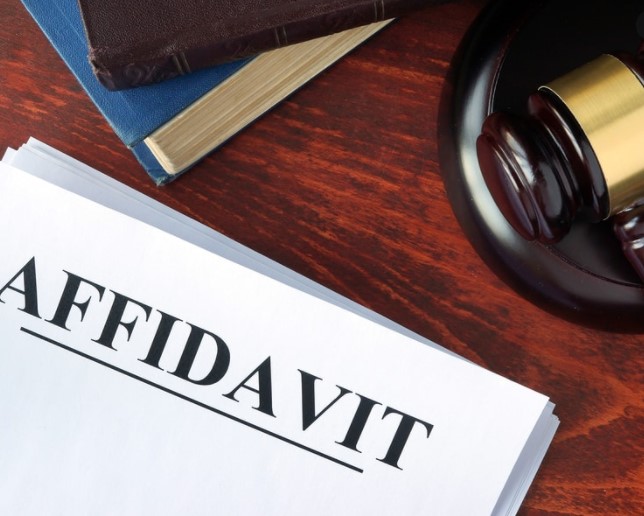A sworn statement made willingly in writing is called an affidavit. It can be used for many reasons including: 1) An attestation of birth; 2) An attestation of death; 3) An attestation of a place of residence; 4) Provision of evidence in a trial by law. Depending on the laws in the jurisdiction and the type of affidavit form, it may need to be signed in front of specific witnesses, involving officers of the law, to be lawfully binding.
Check out other, free downloadable forms here.
What is an Affidavit form?
As we have already mentioned above, a simple affidavit form is a sworn statement created in writing. The party confirms under oath that the declared facts stated in the written statement are true. An affidavit form must be signed in front of an officer who is given an authority to administer such oaths. A general affidavit is the most commonly used statement. Affidavit forms may be used in various scenarios:
1) In business, it is frequently used to certify the financial security of a person applying for a credit card, or a corporation’s financial status.
2) it is mainly used as an evidence in trials and hearings within the judicial system.
3) Affidavit forms may also be used as a proof in administrative and partly judicial proceedings. Yet, this only happens if it is subject to cross-examination and no objection is made to its use.
An affidavit verifies one’s personal information for identification purposes, because it is a legal statement. This may include person’s: full legal name, date of birth and may include person’s social security number in some instances, as well. Affidavit forms must be signed by the person making the sworn statement or affiant in front of a notary public.
When affidavit forms should be used?
Affidavit forms can typically be found in the scenarios as follows: 1) Entering into a contract of agreement; 2) During a court case for both the civil legal process (such as family law) and criminal matters; 3) Applying for work with government agencies; 4) As evidence for administrative hearings; 5) Loss of cell phone or SIM card if you file an insurance claim through the carrier or third-party insurance company; 6) Name change; 7) Requesting a birth certificate or death certificate; 8) To prove your identity if you lose your driver’s license or other identification card
Affidavit types
Not all affidavit forms are the same though they are all utilized to certify that the affiant has personal knowledge of the details within the document. There are specific types of affidavits, including: 1) Affidavit of domicile: Typically used when probating a will or navigating multiple trusts. This affidavit verifies the legal residence of the departed persons at the time of their death. This type of affidavit may be state-specific. 2) Affidavit of heirship: Generally used in estate planning. Commonly, this affidavit is used to establish the legal heirship of the deceased if they died without a valid will. 3) Affidavit of marriage: Declares that two people are lawfully married. These affidavit forms are mostly used when a married couple cannot find their marriage certificate.

Sweepstakes recipients’ affidavits
To confirm the identity of the winner to collect an award, many sweepstakes require a signed and notarized affidavit. This makes certain that the potential winner is who they claim to be and are not fraudulently trying to claim a prize. Affidavits in this scenario verify as follows: 1) The accuracy of the information you entered on your sweepstakes form; 2) That you entered the contest legally and followed the contest rules; 3) That you are eligible to win the sweepstakes; 4) That you agree to the terms of accepting the price (if it is applicable).
Make certain you read the affidavit fully and carefully before signing. Look attentively at what the affidavit requires and be certain you can comply with all the involved provisions for instance, having your picture published etc.
Divorce affidavit
You will provide a financial affidavit during the lawful separation and divorce process. The affidavit components involve details about your: income, assets (like bank accounts, retirement accounts and real property), expenses and debts.
Financial affidavits are utilized to define how assets and debts will be split between the ex-spouses. If you are not honest in this document and try to hide assets, the court may inflict severe penalties, involving awarding 100% of hidden assets to your ex-spouse.
Rules of affidavit to keep in mind:
1) Regulations vary from state to state. In your jurisdiction financial affidavits may be called something a bit different
2) Your attorney for divorce procedures will only review the affidavit for major mistakes. It is your responsibility to make sure all of the details are accurate and complete
3) If your financial circumstances change, you can revise your financial affidavit even after you file it with the court.
You can download other useful, free templates here.
An affidavit including examples for each step
If you have to write or sign an affidavit that is in a standard format, you need to know the main components of the document.
Whether the form is used as: 1) Written, sworn testimony; 2) A health insurance verification letter; 3) The photo page of a passport; 4) A lease agreement; 5) A mortgage application or even in a letter of reference, where you answer some easy questions, it is crucial to make sure that all of the portions are included.
First step is that you should write a title at or near the top of the first page. This title should make it obvious that it is an affidavit form.

Below the title, the full legal name of the affiant (the person attesting to the trustworthiness of whatever is mentioned in the document) must be listed. There also must be documented the names of any other required parties involved. There may be other identifying information as well listed at the top of the form, depending on what is intention of the use of the form.
You will find the main part of the document below the title and identifying information. This contains the assertion. This section of the document is written in the first person. In this part of the document, the affiant will swear or attest that they believe the information provided within the document is sincere to the best of their knowledge.
- The confirmed statements have to be as detailed and clear as possible. Most especially, they must be completely accurate. Or else, the affiant could be charged with the crime of perjury (the offence of willfully telling an untruth). That is why you will find language declaring that the affiant is confirmed the truthfulness of the statements under fine, penalty of perjury and/or confinement. This is a standard section of an affidavit. If the affiant is telling the truth, they have nothing to bother about.
If you are including supporting documents, you must label and organize them by letter, for instance exhibit A, exhibit B etc. Attach them to the end of the final physical document and reference them by label when needed.
The document is unusable if there is no signature of the affiant on it. This should be done in a certification section. There, the affiant must write their legal name and include the date they put the signature on the document. There may be a spot for one or more witnesses as well. This can intensify the legal soundness of the document. The signature of the document should not be done till the affiant and any witness are in front of the notary public.
The final section is reserved for a notary public, who asserts that the affiant is willingly signing the document. This section of the affidavit form should have enough space for the notary public to put signature, date, and stamp the document. In most of the states, a notary public will need a space where they write state-issued notary identification number (ID) number as well.
Make certain that all of the key details listed above are involved in the document if you plan to utilize it. These important sections in your affidavit can secure you from some serious issues. Read it attentively now – or deal with the possible results later.
Parties that are involved in creating an affidavit form
Even though the affiant is the one writing the statemen, writing an affidavit form requires the participation of several parties. The participating parties are: 1) The relevant court or legal entity receiving the affidavit; 2) Affiant: Person who writes and/or files the affidavit; 3) Oath Commissioner or Notary Public: An individual who certifies the signature of the affiant, signs, and seals the affidavit which authenticates it; 4) Witnesses: Generally, two people are required to serve as witnesses to the authenticity of the document.

Affidavit form notarization
An impartial third party, who can lawfully certify the identity of the persons involved in an affidavit is a notary public. When meeting with a notary public, they will ask you to provide a lawful form of identification. They cannot provide any legal advice, so prevent yourself from asking them for input concerning your situation.
Below you can download free template of an affidavit:
